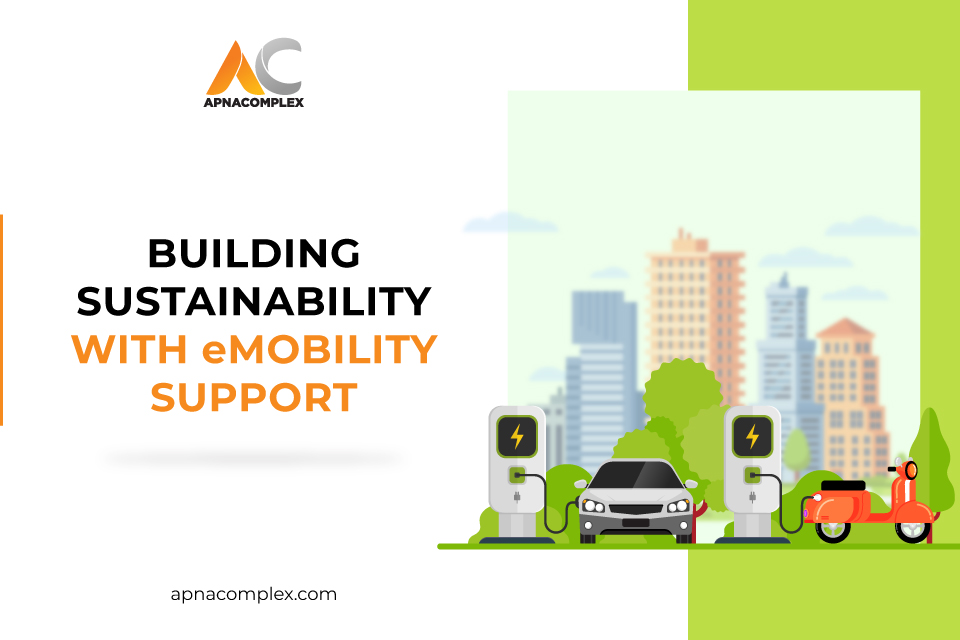Gated Communities Must Move Towards eMobility. Here’s How
Product News clean mobility, Electric vehicles, emobility, EV, EV charging, green technology, National Mobility Mission Plan, net zero solutions, sustainabilityAs Electric Vehicles (EVs) gain wider prominence, the focus has shifted towards strengthening the supporting infrastructure. Resident Welfare Associations (RWAs) and Management Committees (MCs) must share the onus of eMobility by encouraging installation of EV charging stations. The adoption of these measures is critical in ensuring that residents have the support they need to deploy EVs.
Despite its importance, the adoption of EVs is still lagging in many gated communities with a number of RWAs expressing reluctance. However, this is a shortsighted approach since EVs are likely to gain an increasing acceptance in the automobile sector. Failure to adapt to this changing environment can result in conflict and push back any sustainability initiative.
ApnaComplex offers comprehensive support for RWAs and MCs to help them adopt EV charging stations at no extra cost. As a value-added service, it is a critical part of improving the living conditions in gated societies.
eMobility Policy push
The government has been pushing for EVs as part of its net zero goals and to reduce its dependence on fossil fuels. As part of their focus on sustainable and clean mobility solutions, state and central governments have taken various initiatives to meet this goal. The National Electric Mobility Mission Plan lays the roadmap for faster adoption of EVs.
As part of these initiatives, various governments have been transitioning from fuel-guzzling public transportation into EVs. They have also asked for greater public-private partnerships to further push e-mobility. These measures combined with a wider international demand for sustainable solutions have also resulted in a manufacturing push in EVs.
As the technology improves and the government continues to leverage e-mobility, gated communities will see more EVs. This will raise the demand for charging stations as more residents look for eMobility solutions within their residential complexes.
Embracing e-mobility in gated communities
Supporting infrastructure is one of the biggest challenges in the adoption of EVs. The government has tried to resolve this by promoting battery swapping stations across the country. However, the most critical requirement for EV owners is the availability of charging points at home. Apartment complexes can be at a disadvantage since people cannot charge their vehicles at home.
RWAs and MCs should see this as an opportunity to meet their sustainability goals. The installation of charging points in parking areas is critical in meeting this objective. It will allow residents to charge their vehicles at home. As the government tightens e-mobility regulations and more people choose EVs, the availability of charging stations is emerging as one of the prime requirements in gated communities.
Challenges in installation of EV charging points
Despite its importance, there are challenges in installing charger points. These include:
- High charger and installation costs.
- Coordinating with multiple parties
- Allocation of power supply
- Creating a charging schedule for residents
These challenges have been the major stumbling block in the adoption of an EV-friendly infrastructure in gated communities. While the number of EV or hybrid vehicle owners are increasing, quite often there are not enough numbers for the additional investment.
How ApnaComplex facilitates eMobility
As a complete society management solution, ApnaComplex offers value-added services for societies. This includes sustainability solutions like installation of EV charging points at no extra cost. The installation of EV charging points through ApnaComplex has multiple benefits, including:
Free installation: Societies do not have to pay any capital amount for installing EV charging stations.
Earning revenue: Societies have access to additional revenue sources through electric vehicle brand activations. They can earn rent from EV companies for brand placements.
Building sustainability: The availability of charging stations in their parking lot can encourage more residents to buy EVs. Thus, societies can facilitate the objective of meeting net zero goals.
Resident satisfaction: Meeting the emerging needs of residents is important in ensuring resident satisfaction. It reduces conflict between residents and the MCs.
Meeting Government’s green vision: An EV-friendly infrastructure will be critical in meeting the green goals. With the government expected to further tighten regulation on EV adoption, gated communities must be prepared to meet the transition.
You can read about ApnaComplex previous EV charging associations here. If you want to learn more about our EV charging offerings, get in touch with us at support@apnacomplex. Our team will help you understand the best way to adopt an EV charging infrastructure.
